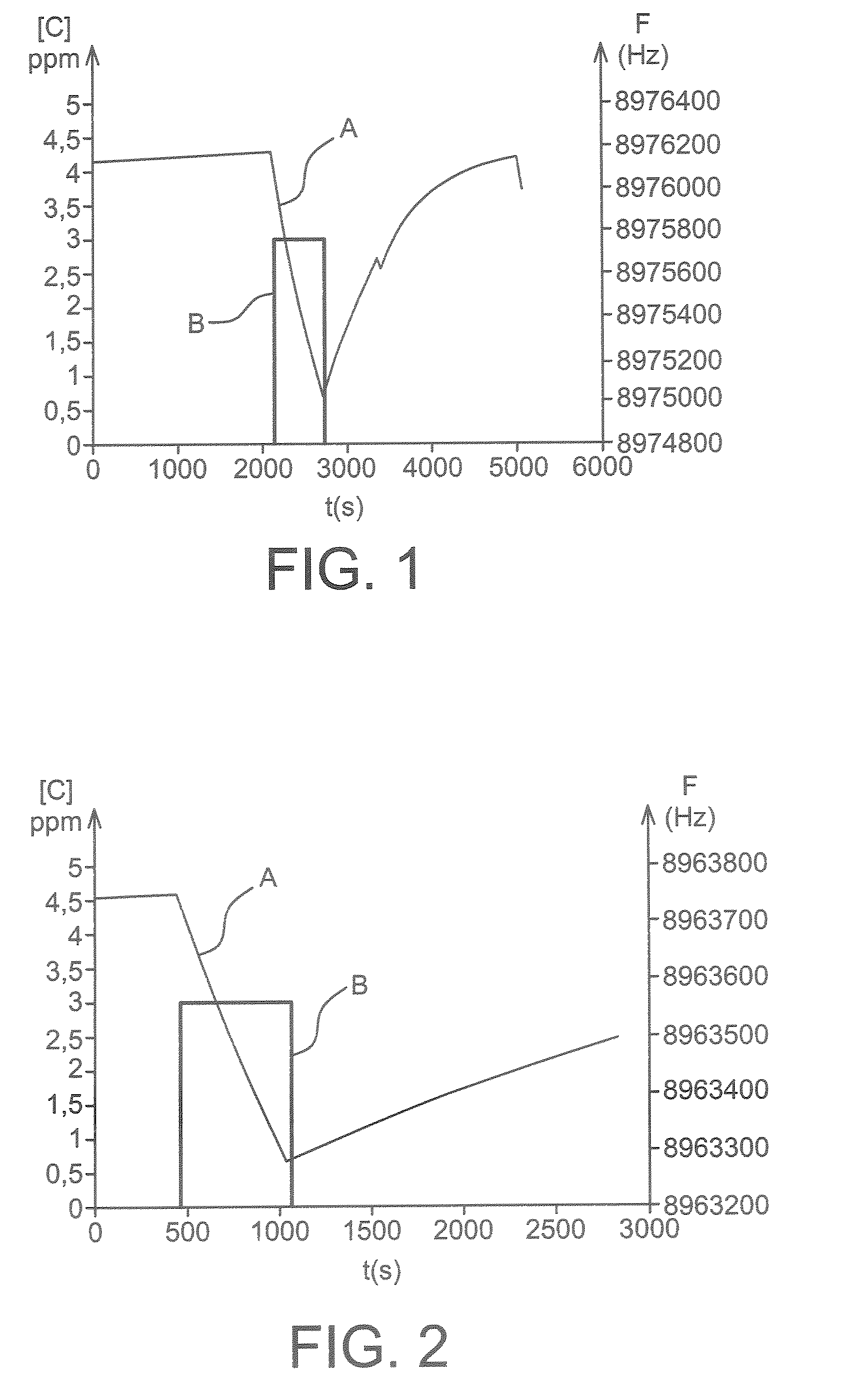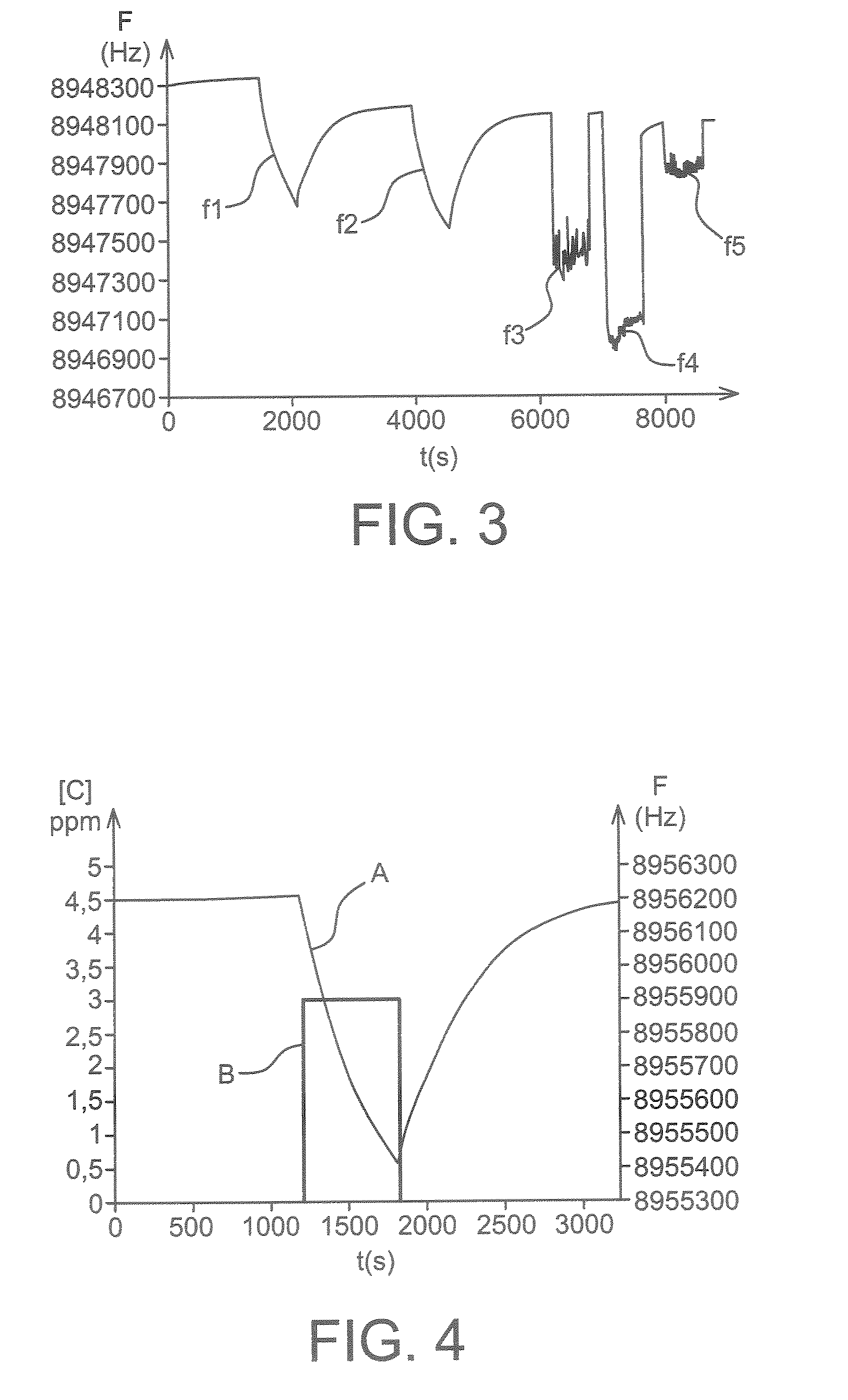Chemical sensors comprising aniline polysiloxanes as sensitive materials and use thereof for detecting of assaying nitro compounds
a technology of aniline polysiloxanes and sensitive materials, which is applied in the direction of material testing goods, biochemistry apparatus and processes, immunoassays, etc., can solve the problems of long training of dogs and their masters, inability to detect explosives, and inability to completely satisfy methods, etc., to achieve convenient transportation and handlability
- Summary
- Abstract
- Description
- Claims
- Application Information
AI Technical Summary
Benefits of technology
Problems solved by technology
Method used
Image
Examples
example 1
Preparation of Aniline-Grafted Polysiloxanes
[0092]Four polymers, respectively denoted hereinafter A, B, C and D, and having the following compositions:
Polymer A:
[0093]Homopolymer of a repeating unit of formula (Ia);
Polymer B:[0094]Random copolymer formed from a repeating unit of formula (Ia) and a dimethylsiloxane repeating unit in a ratio of 0.47 unit of formula (Ia) to 0.53 dimethylsiloxane unit;
Polymer C:[0095]Random copolymer formed from a repeating unit of formula (Ib) and a dimethylsiloxane repeating unit in a ratio of 0.47 unit of formula (Ib) to 0.53 dimethylsiloxane unit;
Polymer D:[0096]Random copolymer formed from a repeating unit of formula (Ic) and a dimethylsiloxane repeating unit in a ratio of 0.47 unit of formula (Ic) to 0.53 dimethylsiloxane unit;
are prepared by modifying polysiloxanes comprising, in the case of the preparation of polymer A, only a methylhydrosiloxane repeating unit of formula (IV) below:
[0097]
and, in the case of the preparation of polymers B, C and ...
example 2
Detection of DNTFMB by a Sensor According to the Invention
[0108]In this example, a quartz microbalance sensor is produced by covering the two faces of an AT cut quartz crystal, with a vibration frequency of 9 MHz, provided with two circular gold measurement electrodes (model QA9RA-50, AMETEK PRECISION INSTRUMENTS) with a thin film of polymer B prepared in accordance with Example 1.
[0109]This film is deposited on each face of the quartz crystal by spraying a 5 g / l solution of polymer B in chloroform 20 times each lasting 0.3 second.
[0110]The change in the vibration frequency of the quartz crystal due to this coating was 9.9 kHz.
[0111]The sensor is exposed successively to:[0112]air for 2100 seconds,[0113]DNTFMB at a concentration of a 3ppm in air for 600 seconds, and[0114]air for 2310 seconds,
the air and the DNTFMB being at ambient temperature.
[0115]FIG. 1 illustrates the change in the vibration frequency of the quartz crystal over the course of these exposures.
[0116]In this figure, c...
example 3
Detection of DNTFMB by a Sensor According to the Invention
[0117]In this example, a quartz microbalance sensor was produced by covering the two faces of a quartz crystal identical to that used in Example 2, with a thin film of polymer A prepared in accordance with Example 1.
[0118]This film is deposited on each face of the quartz crystal by spraying a 10 g / l solution of polymer A in chloroform 8 times, each lasting 0.3 second.
[0119]The change in the vibration frequency of the quartz crystal due to this coating is 9.5 kHz.
[0120]The sensor is exposed successively to:[0121]air for 460 seconds,[0122]DNTFMB at a concentration of 3 ppm in air for 600 seconds, and[0123]air for 1800 seconds,
the air and the DNTFMB being at ambient temperature.
[0124]FIG. 2 illustrates the change in the vibration frequency of the quartz crystal over the course of these exposures.
[0125]In this figure, curve A represents the values of the vibration frequency (F) of the quartz crystal, expressed in Hz (hertz), as a...
PUM
| Property | Measurement | Unit |
|---|---|---|
| thick | aaaaa | aaaaa |
| vibration frequency | aaaaa | aaaaa |
| vibration frequency | aaaaa | aaaaa |
Abstract
Description
Claims
Application Information
 Login to View More
Login to View More - R&D
- Intellectual Property
- Life Sciences
- Materials
- Tech Scout
- Unparalleled Data Quality
- Higher Quality Content
- 60% Fewer Hallucinations
Browse by: Latest US Patents, China's latest patents, Technical Efficacy Thesaurus, Application Domain, Technology Topic, Popular Technical Reports.
© 2025 PatSnap. All rights reserved.Legal|Privacy policy|Modern Slavery Act Transparency Statement|Sitemap|About US| Contact US: help@patsnap.com



